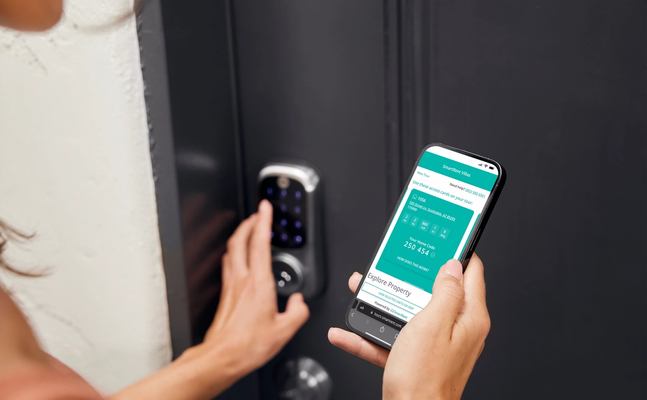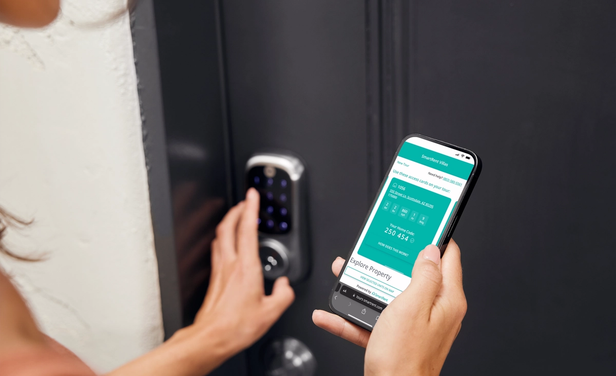Keyless entry is a fast-growing trend among multifamily communities for good reasons: it’s convenient, efficient, and cost effective. Plus, keyless locks offer a ton of benefits that traditional keyed locks don’t. But before you invest in this proptech trend, make sure you know what your options are and what kinds of hardware and systems will give you the most value.
Here’s what you need to know to choose the right keyless entry system for your apartment building.

What is keyless entry?
Keyless entry is a type of access control that uses smart locks to let people move through your multifamily community without having to carry around traditional keys. Some keyless-entry devices replace a metal key with another physical credential like a key fob or key card. Others don’t require a physical credential at all.
Types of keyless entry
There are four types of keyless-entry solutions, depending on what kind of credential you use to unlock a door.
PIN code: You memorize a code, usually at least four digits long, and punch it into a keypad for access.
Mobile: You use your phone to send a digital credential to the reader via Wi-Fi, Bluetooth, Z-wave, or NFC.
Intercom or video-based: Guests and vendors without credentials call a resident or staff member, who opens a door remotely.
Biometric: A keyless reader uses something unique about you to confirm your identity. Facial recognition and fingerprints are the most commonly used biometric credentials, but other options include palm scans, retinal scans, and voice recognition.
Benefits of keyless entry
Keyless entry is one of the most effective proptech investments because it directly benefits everyone in your community.
Owner/operators save money on rekeying locks and distributing new keys if old ones are lost. Keyless entry also makes it easier to monetize certain amenities by activating credentials only for residents who pay for them.
Site teams don’t have to keep track of multiple keys, and it’s easier to manage who gets access to what. They can also restrict access by time of day.
Maintenance teams don’t have to carry lots of keys or keep returning to the office to check them out. And there’s no risk that a lost master key will necessitate rekeying locks.
Residents don’t have to worry about forgetting their keys, and they have more control over who accesses their home and community (like guests and delivery drivers).
Vendors don’t have to make physical contact to get keys, and they don’t have to wait on your site team. They can do their jobs even if your site team isn’t on the premises—like when there’s a late-night plumbing emergency.
Security benefits of keyless entry
Beyond simple gatekeeping, keyless entry has several security-related benefits that regular keyed locks can’t match.
More control: Most forms of keyless entry have no physical credentials that can be lost or stolen. While some forms of keyless entry, like PIN codes, can be shared, many platforms avoid this by allowing you and your residents to create unique codes for each person who enters the community.
Event logs: If there’s a security incident, you can look into the access logs to see which credentials were used and when. This can help you better understand what happened or collaborate with authorities to find a culprit.
Improved self-guided tours: With keyless entry you can see whether a prospect actually attended their tour. And if you want to check on them in person, you can see whether they’ve entered the unit yet or are still touring common areas.
Timely alerts: Some keyless entry systems send notifications when doors are left open, allowing you to secure them immediately.
Ultimately, property owners and residents both love the security aspects of keyless entry because of the peace of mind it brings. Owners appreciate the control and accountability they gain, while residents rest easier knowing their families and possessions are safe and protected.
How to choose the right system for your community
When it comes to keyless entry, there’s no one-size-fits-all solution. The best solution for you depends on how many entry points you have and who’s in your community. You’ll also want to consider what solutions are available in your area—and what access looks like in a blackout or some other unexpected situation.
Step 1: Consider every entry point
Chances are, there are more entry points in your community than those that immediately come to mind, so take a few minutes to write them all down. Walk your property if you need to.
Here are some common entry points:
Units
Gates
Building doors
Garages
Amenity areas
Offices
Storage areas
Once you have a complete list, it’s time to see how the people in your community interact with each entry point.
Step 2: Ask residents and staff about their needs
Think about everyone in your community and how they use your current access control system. Here’s a list of who might need access to your community:
Residents
Guests
Delivery drivers
Resident vendors like dog walkers and housekeepers
Staff
Maintenance technicians
Maintenance vendors like plumbers, electricians, and landscapers
Prospective renters
Emergency responders
While you might not be able to ask a firefighter what kind of lock works best for them, you can talk to your staff, residents, and vendors. Consider observing delivery drivers and dog walkers. And encourage prospective renters to fill out a survey after their tour.
Ask people what they like about your current system and what kinds of upgrades they’d appreciate most. For example, residents often want the ability to remotely grant access to guests and other visitors. Meanwhile, your staff might want to connect access control data with your CRM to learn more about prospects who take self-guided tours.
Step 3: Research solutions thoroughly
Once you have a good idea about how people interact with each entry point, it’s time to check out your options for filling those needs. And that means researching products and solutions.
Consider things like:
Power source: Are locks and readers battery powered, or do you need to run wires to them?
Cost: How much will you need to invest upfront?
Installation: How fast can you get the solution in place, and how complex is setup? Will the solution provider get you started, or will your maintenance team need to do it all?
Integration: How well will a keyless-entry system integrate with other hardware and software you’re already using (or plan to use)?
Level of security: What are the security benefits of each system?
Step 4: Choose hardware options
Now that you’ve researched your needs and options, it’s time to make some decisions—starting with which locks work best where. Go back to your list of entry points and gather your notes on who uses them, then consider which types of locks best meet the needs of everyone who needs access.
Generally, the locks that work best for individual apartments are different from those that work best for common areas. At the apartment level, residents and maintenance teams might do well with a PIN code and mobile credential options. But at the front gate, vendors and guests might appreciate an intercom option.
Consider how much use each lock will get. If people are in and out all the time, battery-powered locks might not be the best choice. Either find hardware with long battery life or consider a wired option.
Step 5: Build in a backup plan
As you consider which kind of reader should go where, don’t forget to consider how people will use a lock if their preferred option isn’t available. If a resident's phone battery is dead and they can’t use their mobile credential, how will they get in? If the electricity goes out, do you have a backup generator to keep wired locks functioning?
Many solutions offer hardware that takes more than one kind of credential. These devices give people convenient options to choose from when everything’s running as planned and provide backup options in case something goes wrong.

Finding the right entry system is key
Keyless entry can be more convenient, efficient, and cost effective than traditional keyed locks. That makes it a great fit for multifamily communities that want to centralize operations and boost NOI while also attracting and retaining high-quality renters.
Choosing the right keyless entry system is critical for getting the most out of your investment. But if you build a solution around the needs of your community, you’ll get a solid ROI and lay the groundwork for other improvements like more efficient maintenance and self-guided tours. Check out SmartRent’s customizable solutions to find out how you can use keyless entry to build a smarter multifamily community.

